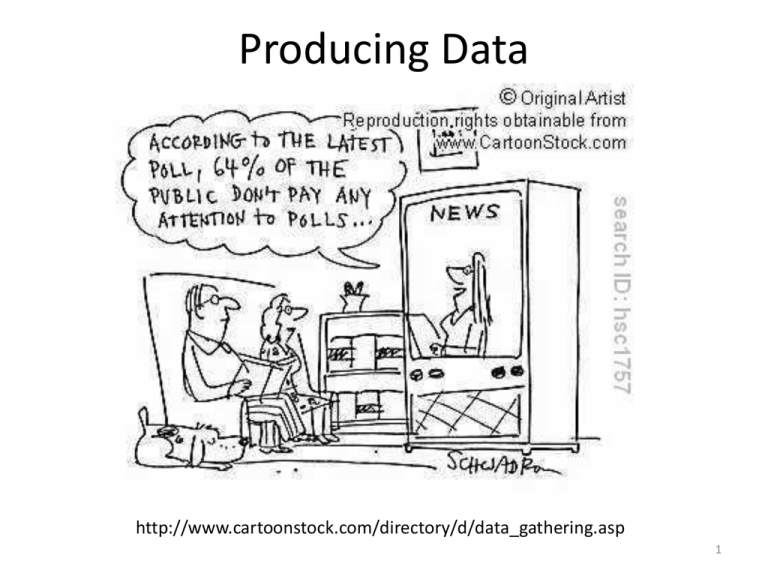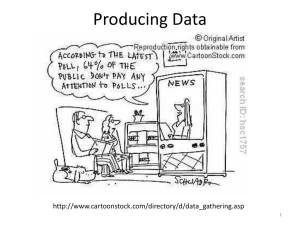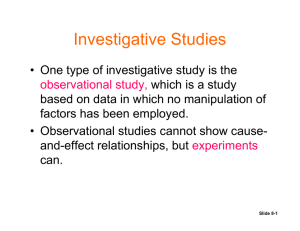Producing Data 1
advertisement

Producing Data http://www.cartoonstock.com/directory/d/data_gathering.asp 1 Sources of Data - Goals • Identify anecdotal data in a specific situation and explain why we should not use this type of data. • Define what is meant by available data. • Distinguish between experiments and observational studies. 2 Anecdotal Data Anecdotal data represent individual cases that often come to our attention because they are striking in some way. A woman who was deaf from birth was hit by lightning and regained her hearing. Does this mean that lightning is a cure for deafness? 3 Available Data Available data are data that were produced in the past for some other purpose but that may help answer a present question inexpensively. The library and the Internet are sources of available data. 4 Observational Studies and Experiments • In an experimental study, we investigate the effects of certain conditions on individuals or objects in the sample. • In an observational study, we observe the response for a specific variable for each individual or object. 5 Observational Data In an article published in the Journal of the American Veterinary Medical Association, Whitney and Mehlaff (1987) presented results on the injury rates of cats that had plummeted from buildings in New Your City according to the number of floors that they had fallen. The researches merely recorded the number of injuries from the cats that were brought into the vet. No cats were thrown from the windows – the cats did it to themselves! The Analysis of Biological Data, Whitlock, Schluter, 2009, Roberts and Company, p. 3 6 Designing Experiments and Observational Studies - Goals • In experiments, identify the units or subjects, treatments or factors and outcomes. • Identify a comparative experiment and explain why they are used. • Be able to apply the basic principles of experimental design: compare, randomize and repeat. • Be able to identify common problems in design: – Bias – Over generalization • Be able to identify matched pairs design and block design and explain why they are used. 7 Terms used in experiments • Experimental units • Treatment or factor – Level • Outcome • Statistically significant – An observed effect so large that it would rarely occur by chance. 8 Example: Terminology of Experimental Design For each of the following, define the experimental unit, factor, levels, response variable and what would be statistically significant. 1) In a study of cell phone usage by college students, we want to know how much time is being spent on different types of apps on the phones. 2) In a study of sickle cell anemia, 150 patients were given the drug hydroxyurea, and 150 were given a placebo (dummy pill). The researchers counted the episodes of pain in each subject. 9 Principles of Experimental Design 1. Control: Compare two or more treatments. 2. Randomize: use chance to assign experimental units to treatments. 3. Replication: Use enough experimental units in each group to reduce chance variation in the results. 10 Comparative Experiments Experimental units Measure response Treatment Control Measure response Compare results Experimental units Treatment Measure response 11 Bias The design of a study is biased if it systematically favors certain outcomes. An investigator is interested if the size of fish versus the size of the lake that they are in. A number of lakes are chosen in a particular area and the investigator uses nets to catch the fish. 12 Principles of Experimental Design 1. Control: Compare two or more treatments, 2. Randomize: use chance to assign experimental units to treatments. 3. Replication: Use enough experimental units in each group to reduce chance variation in the results. 13 Randomized Experiments • In a completely randomized design, the treatments are assigned to all the experimental units completely by chance. Group 1 Experimental units Treatment 1 Compare results Random assignment Group 2 Treatment 2 14 Randomization 1. Label each of the N individuals. 2. Put the N numbers into a hat. 3. Draw the numbers one at a time until you have n individuals. 15 Principles of Experimental Design 1. Control: Compare two or more treatments, 2. Randomize: use chance to assign experimental units to treatments. 3. Replication: Use enough experimental units in each group to reduce chance variation in the results. 16 Cautions about Experimentation 1. Bias 2. Generalization 17 Lack of Realism 1. Is studying the effects of eating red meat on cholesterol values in a group of middle aged men a realistic way to study factors affecting heart disease problems in humans? 2. Is studying the effects of hair spray on rats a realistic way to determine what will happen to women with large amounts of hair? 18 Other Designs • A matched pair design is when each experimental unit is matched with another one. • A block is a group of experimental units that are similar. • In a block design, the random assignment of experimental units to treatments is carried out within each block. • Control what you can, block what you can’t control, and randomize to create comparable groups. 19 Sampling Design - Goals • Be able to determine and explain when a probability sample, simple random sample or a stratified random sample is the preferred method. • Be able to state when there is a response bias with obtaining a sample: convenience sample, nonresponse 20 Population and Sample • Population: the entire group of objects that we want information about. • Sample: the part (subset) of the population that we actual examine. 21 Sampling Methods • Probability Sample • Simple Random Sample (SRS) • Stratified Random Sample 22 SRS A (simple) random sample (SRS) of size n is a sample selected in such a way that every possible sample of size n has the same chance of being selected. • Method 1. Label every object from 1 to n. 2. Generate random numbers to select the objects. 3. You are done when you have selected n different objects. 23 Stratified Random Samples • Procedure 1. Divide the population into groups into strata. 2. Choose a SRS fro each group. 24 Response Bias • Convenience sample • Undercoverage • Nonresponse Your random sample needs to be representative of the population. 25 Bias vs. Variability 26 Managing Bias and Variability • To reduce bias, use random sampling. • To reduce variability of a statistic from an SRS, use a larger sample 27 Statistical Inference • Sample has to be representative of the population – Randomize • The experiment has to be performed in such a way that you can obtain the data that you are interested in. • Perform the correct analysis. 28 Causality http://www.forbes.com/sites/erikaandersen/2012/03/23 /true-fact-the-lack-of-pirates-is-causing-global-warming/ 29 Causality - Goals • Be able to determine if a variable is lurking or confounding. • Be able to explain an association in terms of – Causation – Common response – Confounding variables • Apply the criteria for establishing causation. • Association and causation are NOT the same thing. • Interpret examples in terms of Simpson’s paradox. 30 Causality • A lurking variable is a variable that is not among the explanatory or response variables in a study but that may influence the variables in the study. • Confounding occurs when two variables are associated in such a way that their effects on a response variable cannot be distinguished from each other. 31 Lurking Variables In each case, what is the lurking variable? 1. For children, there is an extremely strong correlation between shoe size and math scores. 2. There is a very strong correlation between ice cream sales and number of deaths by drowning. 3. There is very strong correlation between number of churches in a town and number of bars in a town. 32 Lurking Variable? http://www.forbes.com/sites/erikaandersen/2012/03/23 /true-fact-the-lack-of-pirates-is-causing-global-warming/ 33 Causation Association does not mean causation! 34 Establishing Causation Perform an experiment! What do we need for causation? 1. The association is strong. 2. The association is consistent. The connection happens in repeated trials The same connection happens under varying conditions 3. Alleged cause precedes the effect. 4. The alleged cause is plausible. 35 Simpson’s Paradox An association or comparison that holds for all of several groups can reverse direction when the data are combined to form a single group. This reversal is called Simpson’s paradox. 36 Simpson’s Paradox Consider the acceptance rates for the following groups of men and women who applied to college. Counts Accepted Not accepted Total Men 198 162 360 Women 88 112 200 Total 286 274 560 Percents Accepted Not accepted Men 55% 45% Women 44% 56% 37 Simpson’s Paradox • Business School Counts Accepted Men 18 Not accepted 102 Women 24 96 120 Total 42 198 Percents Accepted Not accepted Men 15% 85% 240 Women 20% 80% Total Percents Accepted Not accepted Men 75% 25% Women 80% 20% Total 120 • Art School Counts Accepted Men Women Total 180 64 244 Not accepted 60 16 76 240 80 320 38 Provide All the Critical Information Papers reporting scientific research are supposed to be short, with no extra baggage. Brevity, however, can allow researchers to avoid complete honesty about their data. Did they choose their subjects in a biased way? Did they report data on only some of their subjects? Did they try several statistical analyses and report only the ones that looked best? The statistician John Bailar screened more than 4000 medical papers in more than a decade as consultant to the New England Journal of Medicine. He says, “When it came to the statistical review, it was often clear that critical information was lacking, and the gaps nearly always had the practical effect of making the authors’ conclusions look stronger than they should have.” The situation is no doubt worse in fields that screen published work less carefully. 39 In-class discussion on Data Ethics Should we allow this personal information to be collected? 1. A government agency takes a random sample of income tax returns to obtain information on the average income of people in different occupations. Only the incomes and occupations are recorded from the returns, not the names. 2. A social psychologist attends public meetings of a religious group to study the behavior patterns of members, 3. A social psychologist pretends to be converted to membership in a religious group and attends private meetings to study the behavior patterns of members. 40





